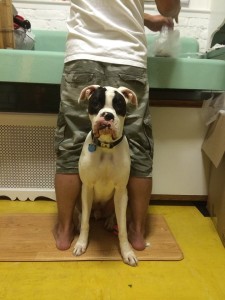
First, A boxer is a boxer whether they are deaf or not. A deaf boxer needs the same things a hearing boxer needs. They just need it in a different way. Just like humans rely on other senses when one is impaired- dogs do the same, they compensate. Deaf boxers utilize vibration and movement to determine what you are saying. Before we get to the 4 quick tips, I’d like to tell you about Cassius (pictured above), a white deaf boxer. Well in case you haven’t noticed, he is adorable! He is also loveable and very playful and smart, as you would expect from any boxer. His family (James Lee) describes him as a…
1 1/2 year old, white boxer who is gentle yet full of energy, curious, goofy (bull in a china shop kind of dog), happy and deaf.
He has carefully placed black spots that looks like a kid started to paint him. One spot on each eye, a tiny drip on his ear and a splash on his nubbin. He has an over-sized tongue that hangs out of the side of his mouth… almost always. He can give a bit of attitude and stubbornness as a typical boxer.
He I runs like a horse, prances like a deer, shadows freak him out and he barks like he can hear (you know what I’m talking if you’ve heard a deaf dog bark).
Take out all the words deaf from this description – would you know that he is deaf? Probably not, right? I think most people forget that we teach our boxers our language whether it be English, Spanish, French, or Sign. Training a deaf boxer isn’t that much different than training a hearing boxer. Here are 4 quick tips on how to train a deaf boxer:
- Be Clear and Concise when you Communicate. Teach your boxer sign language. For example, tap your boxer once (always use the same spot) to let them know to watch you and that you need to communicate. More signs, can be found here. Consistency and repetition are key.
- Use Positive Reinforcement! Remember you are training with your hands by signing, so you should never use your hands to punish! Use a primary reinforcer – FOOD/TREATS to reward. Dogs have an incredible sense of smell, use it to your advantage!
- Safety Proof the Environment! Use a kennel or crate for your boxer when they are alone. Make sure your yard is secure. And always use a leash when walking a deaf dog. You should also use a collar that indicates the dog is deaf, in the event that your boxer is lost or so anyone you approach knows your boxer is deaf (see it here). Use night lights -dark and deaf would be scary to you and it is to a boxer as well.
- Socialize Your Boxer. The more you socialize your boxer with touch, the better. This teaches them not to be startled by touch. Make sure you do this in all environments. Use vibrations to help alert your boxer, such as touching their bed when they are sleeping and walking heavily when you enter a room.
Here is a great book that gives great training techniques and is very useful.
Always remember that your deaf boxer is a part of your family. They love, they wiggle, and they FEEL just like any other boxer.
Thank you to James Lee and his family for sharing such a beautiful description of Cassius and for all the adorable pictures as well.










I’ve actually been to a wedding with Cassius and he is a party animal!